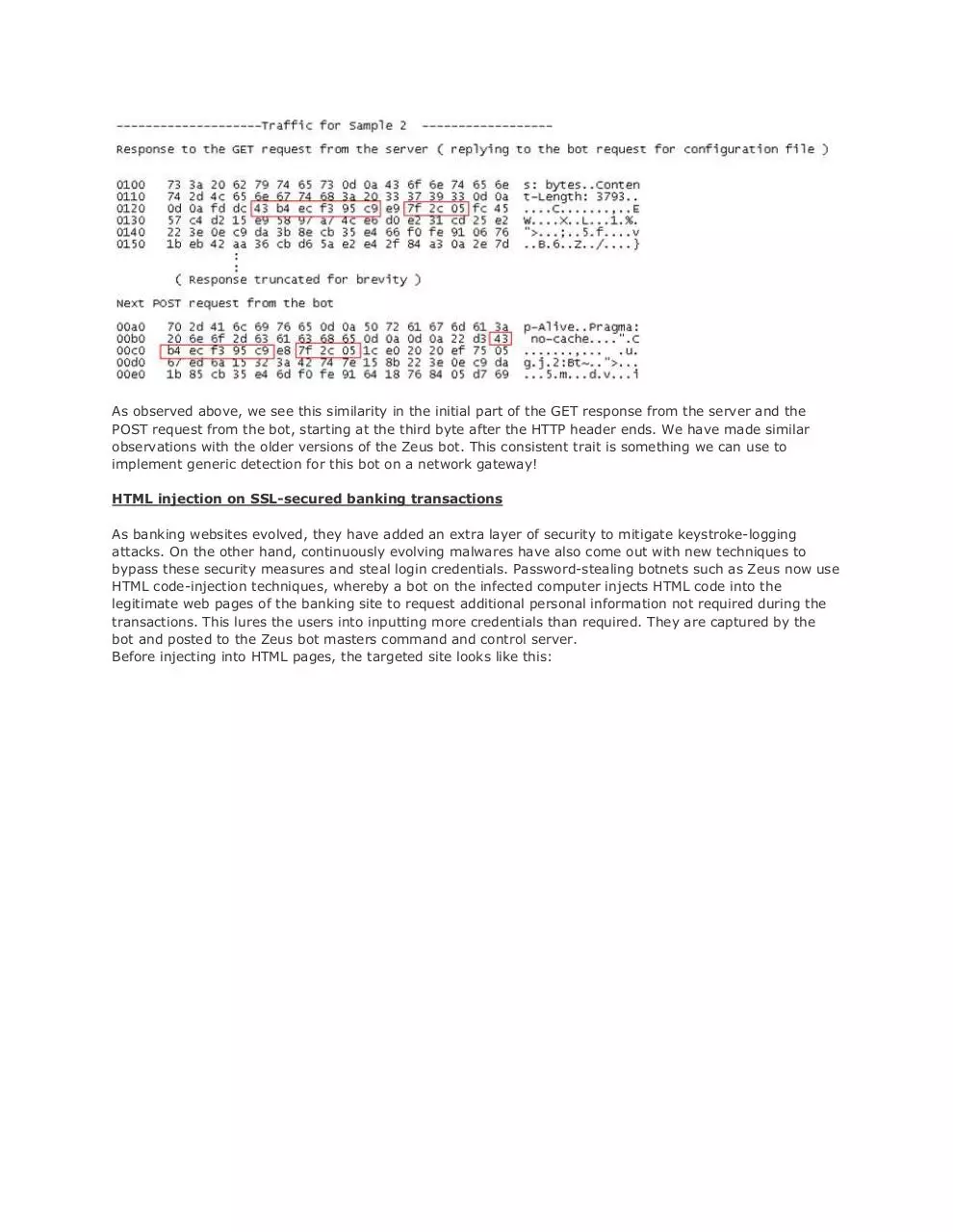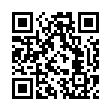Zeus Crimeware Toolkit (PDF)
File information
Author: Moos
This PDF 1.5 document has been generated by Microsoft® Office Word 2007, and has been sent on pdf-archive.com on 26/03/2011 at 22:37, from IP address 195.242.x.x.
The current document download page has been viewed 2876 times.
File size: 500.78 KB (12 pages).
Privacy: public file





File preview
Zeus Crimeware Toolkit
www.h4cky0u.org
Author: http://blogs.mcafee.com/mcafee-labs/zeus-crimeware-toolkit
The Zeus botnet has been in the wild since 2007 and it is among the top botnets active today. This bot has
an amazing and rarely observed means of stealing personal information–by infecting users‟ computers and
capturing all the information entered on banking sites. Apart from stealing passwords, this bot has variety of
methods implemented for stealing identities and controlling victims‟ computers.
Over the years Zeus has been released in a lot of versions, adding or changing functionality, and is highly
flexible in its configuration. So this is just a snapshot of one version (1.2.7.19), giving an overview of its
functionality.
In the first part of this blog I will disclose the process involved in building and distributing a Zeus botnet in
the wild. In the second part, I will discuss how Zeus captures personal information by injecting code
dynamically, and finally I‟ll offer some thoughts on command and control.
Zeus serves as a heads up for all those who believe that banking transactions on HTTPS can never be
intercepted.
Zeus builder toolkit
I‟ve been busy researching how Zeus is built and distributed in the wild. It has been a pretty high-profile
botnet since it was discovered, due to its high rate of infections. During our research activity I was able to
get hold of a Zeus builder toolkit. It was priced at US$700 to $1,500 then; a few months later, a free
version of this toolkit was public.
Building and Configuring Zeus Bot
The process of building and configuring the Zeus bot requires just a couple of steps.
Step 1) Configuration specification:
Specifying all the static configuration parameters in the configuration file.
The “edit config”• button will allow you to enter various parameters to control the botnet as  described
below.
timer_logs : Time interval to upload the logs to server
timer_stats : Time interval to upload infection statistics to server
url_config : Server URL for fetching the config file
url_compip : Server URL for reporting the victim
encryption_key : Encryption key to encrypt config file
url_loader : URL for fetching latest version of the zeus.exe
url_server : Command and control server
file_webinjects: This parameter is the file name containing HTML web injection code.
AdvancedConfigs : URL for fetching the backup config file
WebFilters : Contains the masked list of URLs that should be monitored for capturing login credentials.
WebDataFilters: Contains the list of URLs that should be monitored for specific string matches. If patterns
such as “Passw” or “login” is matched, data is captured and sent to C&C server,
e.g., http://mail.rambler.ru/*” “passw;login”
WebFakes: URLs that should be redirected to the fake websites
TANGrabber:
TAN (Transaction Authentication Number) Grabber is a Zeus feature that allows the bot master to specify the banking sites
to monitor and the specific patters to search for in the transaction data posted to the bank websites. Zeus will match these
specified data patterns, capture them, and post them on the C&C server. The Bot master can enter other banking sites
here and Zeus will add them in the final encrypted configuration file when the “Build config” button is clicked.
I entered the fake banking URL in the config file below, marked in Red, just to check its presence when the encrypted
configuration file is built.
Step 2) Building an encrypted configuration file
Let‟s have a look what happens when we press the “Build config”• button. The toolkit will build the final
encrypted configuration file with an option to save it. This configuration file is then uploaded by the bot
master on the C&C server.
Step 3) Building the bot executable
The bot master can build the Zeus executable with the “Build loader”• button option.
Zeus Network Communications
When the bot is executed in a virtual machine, initially it communicates over HTTP and sends a GET request
to the command and control server to retrieve the configuration file. The server replies with the requested
configuration file. This request is made repeatedly on the basis of the timer value configured in the
configuration file.
The bot sends the information of the infected computer to the control server according to the “url_server”•
parameter specified in the configuration file.
One interesting observation
Upon closer analysis of the Zeus network communications, we have come across an interesting similarity
between the GET response from the server and the next POST request sent by the bot.
For sample 1:
For sample 2:
As observed above, we see this similarity in the initial part of the GET response from the server and the
POST request from the bot, starting at the third byte after the HTTP header ends. We have made similar
observations with the older versions of the Zeus bot. This consistent trait is something we can use to
implement generic detection for this bot on a network gateway!
HTML injection on SSL-secured banking transactions
As banking websites evolved, they have added an extra layer of security to mitigate keystroke-logging
attacks. On the other hand, continuously evolving malwares have also come out with new techniques to
bypass these security measures and steal login credentials. Password-stealing botnets such as Zeus now use
HTML code-injection techniques, whereby a bot on the infected computer injects HTML code into the
legitimate web pages of the banking site to request additional personal information not required during the
transactions. This lures the users into inputting more credentials than required. They are captured by the
bot and posted to the Zeus bot masters command and control server.
Before injecting into HTML pages, the targeted site looks like this:
After injecting into HTML pages, same targeted site looks like this:
This shows even forms that are supposed to be HTTPS encrypted can be manipulated by a bot to entice the
user into typing arbitrary amounts of personal information, which can be captured (using key logging) and
sent off to the C&C master.
Heuristic detection for web injection activity:
Another technique that can be used is detecting the difference in the HTML form fields. The idea is to
detect the change in the number of HTML form fields while accessing the banking site and when the data is
posted on the server. This can be detected on the Network gateway. In the case of Zeus, as the banking
sites are accessed over HTTPS, the perimeter device needs to be armed with SSL man-in-the-middle
functionality to detect this form of network traffic.
Intercepting mouse clicks and capturing virtual keyboard screenshots
Banking websites have come up with the virtual keyboard technique to mitigate the keystroke-logging
attacks. Zeus counterattacks this security feature by capturing the screenshots on each mouse click. Each
click will be intercepted and a screenshot captured that will be sent to the drop server which is then
combined sequentially to extract the entered password as shown below.
Analysis of the decrypted configuration file
Once a machine is infected with the Zeus bot, you can use the Zeus decoder tool available here to decrypt
the encrypted config file.
Let„s take a look at the decrypted config file. We see the HTML injection code that this bot has added into it.
http://172.16.230.183/bt.exe
http://172.16.230.183/gate.php
!*.microsoft.com/*
!http://*myspace.com*
https://www.gruposantander.es/*
!http://*odnoklassniki.ru/*
!http://vkontakte.ru/*
@*/login.osmp.ru/*
@*/atl.osmp.ru/*
https://banking.*.de/cgi/ueberweisung.cgi/*
*&tid=*
*&betrag=*
https://internetbanking.gad.de/banking/*
KktNrTanEnz
https://www.citibank.de/*/jba/mp#/SubmitRecap.do
SYNC_TOKEN=*
https://www.mybank.com/loginform.asp
(Fake banking URL that I added while building the config file.)
HTML injection code in the config file:
Following is the abbreviated list of banking sites targeted by this bot; it‟s found in the decrypted
configuration file.
https://online.wellsfargo.com/signon*
https://www.paypal.com/*/webscr?cmd=_account
https://www.paypal.com/*/webscr?cmd=_login-done*
https://www#.usbank.com/internetBanking/LoginRouter
https://easyweb*.tdcanadatrust.com/servlet/*FinancialSummaryServlet*
https://www#.citizensbankonline.com/*/index-wait.jsp
https://onlinebanking.nationalcity.com/OLB/secure/AccountList.aspx
https://www.suntrust.com/portal/server.pt*parentname=Login*
https://www.53.com/servlet/efsonline/index.html*
https://web.da-us.citibank.com/*BS_Id=MemberHomepage*
https://onlineeast#.bankofamerica.com/cgi-bin/ias/*/GotoWelcome
https://online.wamu.com/Servicing/Servicing.aspx?targetPage=AccountSummary
https://onlinebanking#.wachovia.com/myAccounts.aspx?referrer=authService
https://resources.chase.com/MyAccounts.aspx
https://bancaonline.openbank.es/servlet/PProxy?*
https://extranet.banesto.es/*/loginParticulares.htm
https://banesnet.banesto.es/*/loginEmpresas.htm
https://empresas.gruposantander.es/WebEmpresas/servlet/webempresas.servlets.*
https://www.gruposantander.es/bog/sbi*?ptns=acceso*
https://www.bbvanetoffice.com/local_bdno/login_bbvanetoffice.html
https://www.bancajaproximaempresas.com/ControlEmpresas*
https://www.citibank.de*
https://probanking.procreditbank.bg/main/main.asp*
https://ibank.internationalbanking.barclays.com/logon/icebapplication*
https://ibank.barclays.co.uk/olb/x/LoginMember.do
https://online-offshore.lloydstsb.com/customer.ibc
https://online-business.lloydstsb.co.uk/customer.ibc
https://www.dab-bank.com*
http://www.hsbc.co.uk/1/2/personal/internet-banking*
https://www.nwolb.com/Login.aspx*
https://home.ybonline.co.uk/login.html*
https://home.cbonline.co.uk/login.html*
https://welcome27.co-operativebank.co.uk/CBIBSWeb/start.do
https://welcome23.smile.co.uk/SmileWeb/start.do
https://www.halifax-online.co.uk/_mem_bin/formslogin.asp*
https://www2.bancopopular.es/AppBPE/servlet/servin*
https://www.bancoherrero.com/es/*
https://pastornetparticulares.bancopastor.es/SrPd*
https://intelvia.cajamurcia.es/2043/entrada/01entradaencrip.htm
https://www.caja-granada.es/cgi-bin/INclient_2031
https://www.fibancmediolanum.es/BasePage.aspx*
https://carnet.cajarioja.es/banca3/tx0011/0011.jsp
https://www.cajalaboral.com/home/acceso.asp
https://www.cajasoldirecto.es/2106/*
https://www.clavenet.net/cgi-bin/INclient_7054
https://www.cajavital.es/Appserver/vitalnet*
https://banca.cajaen.es/Jaen/INclient.jsp
https://www.cajadeavila.es/cgi-bin/INclient_6094
https://www.caixatarragona.es/esp/sec_1/oficinacodigo.jsp
http://caixasabadell.net/banca2/tx0011/0011.jsp
https://www.caixaontinyent.es/cgi-bin/INclient_2045
https://www.caixalaietana.es/cgi-bin/INclient_2042
https://www.cajacirculo.es/ISMC/Circulo/acceso.jsp
https://areasegura.banif.es/bog/bogbsn*
https://www.bgnetplus.com/niloinet/login.jsp
https://www.caixagirona.es/cgi-bin/INclient_2030*
https://www.unicaja.es/PortalServlet*
https://www.sabadellatlantico.com/es/*
https://oi.cajamadrid.es/CajaMadrid/oi/pt_oi/Login/login
https://www.cajabadajoz.es/cgi-bin/INclient_6010*
https://extranet.banesto.es/npage/OtrosLogin/LoginIBanesto.htm
https://montevia.elmonte.es/cgi-bin/INclient_2098*
https://www.cajacanarias.es/cgi-bin/INclient_6065
https://oie.cajamadridempresas.es/CajaMadrid/oie/pt_oie/Login/login_oie_1
https://www.gruppocarige.it/grps/vbank/jsp/login.jsp
https://bancopostaonline.poste.it/bpol/bancoposta/formslogin.asp
https://privati.internetbanking.bancaintesa.it/sm/login/IN/box_login.jsp
https://hb.quiubi.it/newSSO/x11logon.htm
https://www.iwbank.it/private/index_pub.jhtml*
https://web.secservizi.it/siteminderagent/forms/login.fcc
https://www.isideonline.it/relaxbanking/sso.Login*
Botnet Command and Control
This toolkit comes with a control panel installation that is typically used to track the botnet infections. This is
a PHP application that can be run on a web server along with the other required database software (MYSQL).
It also enables the attacker to remotely control and send commands to the victims‟ computers.
I opened one of the scripts that came with this toolkit and I found the bot can be given the following
commands:
$_COMMANDS_LIST = array
(
„reboot„ => „Reboot computer.‟,
„kos„ => „Kill OS.‟,
„shutdown„ =>Â „Shutdown computer.‟,
„bc_add [service] [ip] [port]„ => „Add backconnect for [service] using server witn address [ip]:[port].‟,
„bc_del [service] [ip] [port]„ => „Remove backconnect for [service] (mask is allowed) that use connection to
[ip]:[port] (mask is allowed).‟,
„block_url [url]„Â Â => „Disable access to [url] (mask is allowed).‟,
„unblock_url [url]„ => „Enable access to [url] (mask is allowed).‟,
„block_fake [url]„Â Â => „Disable executing of HTTP-fake/inject with mask [url] (mask is allowed).‟,
„unblock_fake [url]„ => „Enable executing of HTTP-fake/inject with mask [url] (mask is allowed).‟,
„rexec [url] [args]„Â Â => „Download and execute the file [url] with the arguments [args] (optional).‟,
„rexeci [url] [args]„ => „Download and execute the file [url] with the arguments [args] (optional) using
interactive user.‟,
„lexec [file] [args]„ => „Execute the local file [file] with the arguments [args] (optional).‟,
„lexeci [file] [args]„ => „Execute the local file [file] with the arguments [args] (optional) using interactive
user.‟,
„addsf [file_mask...]„ => „Add file masks [file_mask] for local search.‟,
„delsf [file_mask...]„ => „Remove file masks [file_mask] from local search.‟,
„getfile [path]„ => „Upload file or folder [path] to server.‟,
„getcerts‟ => „Upload certificates from all stores to server.‟,
„resetgrab‟ => „Upload to server the information from the protected storage, cookies, etc.‟,
„upcfg [url]„ => „Update configuration file from url [url] (optional, by default used standard url)‟,
„rename_bot [name]„ => „Rename bot to [name].‟,
„getmff‟ => „Upload Macromedia Flash files to server.‟,
„delmff‟ => „Remove Macromedia Flash files.‟,
„sethomepage [url]„ => „Set homepage [url] for Internet Explorer.‟
We found an interesting feature of this toolkit during the botnet building process: If the bot master
accidently infects his own computer, he can remove the botnet with the “Remove spyware from this
system”• button. Too bad that command isn‟t available to Zeus‟ victims.
Resource:
http://blogs.mcafee.com/mcafee-labs/zeus-crimeware-toolkit
Download Zeus-Crimeware-Toolkit
Zeus-Crimeware-Toolkit.pdf (PDF, 500.78 KB)
Download PDF
Share this file on social networks
Link to this page
Permanent link
Use the permanent link to the download page to share your document on Facebook, Twitter, LinkedIn, or directly with a contact by e-Mail, Messenger, Whatsapp, Line..
Short link
Use the short link to share your document on Twitter or by text message (SMS)
HTML Code
Copy the following HTML code to share your document on a Website or Blog
QR Code to this page

This file has been shared publicly by a user of PDF Archive.
Document ID: 0000029531.